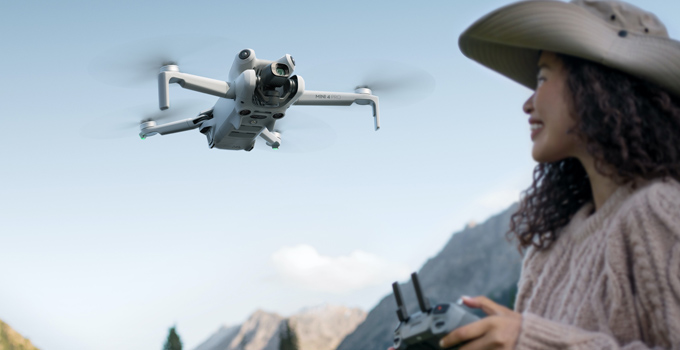DJI Launches Air 3S Drone with Enhanced Dynamic Range for Travel Cinematography
DJI continues to push the boundaries of aerial cinematography with the introduction of its latest drone, the Air 3S. Designed with content creators in mind, the Air 3S is a powerhouse for capturing breathtaking landscapes and stunning travel footage—especially in challenging lighting conditions. With its remarkable features, this drone sets a new standard for those who need high-quality video capture on the go.

Unparalleled Dynamic Range for Stunning Visuals
One of the standout features of the DJI Air 3S is its 1-inch CMOS sensor, which supports 10-bit video and offers up to 14 stops of dynamic range. This means it excels in capturing a wide range of light, from the darkest shadows to the brightest highlights, making it perfect for shooting travel videos, landscapes, and scenes with complex lighting.
Whether you’re filming sunrises over mountains or vibrant cityscapes at dusk, the Air 3S provides incredible detail and depth. The ability to shoot in D-Log and Hybrid Log Gamma (HLG) modes adds versatility, giving videographers more control over color grading and post-production. This feature is especially beneficial for creating cinematic videos with rich, dynamic tones, even in low-light environments.
Dual Cameras for Versatile Shooting
The DJI Air 3S offers dual-camera capabilities, giving users the flexibility to capture a range of shots:
24mm wide-angle camera: This camera is equipped with a 1-inch 50MP CMOS sensor, perfect for wide, expansive shots that showcase the beauty of landscapes and natural scenery.
70mm medium telephoto camera: Featuring a 48MP 1/1.3-inch sensor with 3x optical zoom, this camera delivers detailed images with reduced distortion, making it ideal for close-ups of architectural elements or distant wildlife.
This dual-camera setup ensures that you’re ready to capture any scene, whether it’s an expansive vista or a detailed close-up.

Exceptional Low-Light Performance
Travel cinematographers often encounter less-than-ideal lighting conditions, especially when filming at dawn, dusk, or at night. Thanks to the Air 3S’s large 3.2μm pixel size and its sophisticated sensor technology, it handles low-light situations with ease. The drone captures vibrant sunsets and urban nightscapes with stunning clarity and minimal noise, ensuring that even in low light, your footage remains sharp and visually striking.
Smooth Video and Efficient Encoding
The DJI Air 3S supports 10-bit 4K video recording using H.265 encoding and DJI’s refined color science, which ensures accurate color reproduction. Not only does this provide flexibility in post-production, but it also allows you to capture natural-looking scenes that pop with detail and color.
What’s more, DJI has improved the video encoding algorithms in the Air 3S, enabling up to 30% smaller file sizes compared to the previous Air 2S model. This means you can store more footage without compromising quality, making it ideal for long-travel shoots where storage might be limited.

Advanced Features for Enhanced Control
The Air 3S comes packed with intelligent flight features that make capturing cinematic shots easier than ever. The ActiveTrack 360° keeps subjects perfectly framed, while the subject-focusing feature ensures sharp focus even when the subject moves off-center. These features, combined with omnidirectional obstacle sensing via infrared and 360° vision sensors, make navigating complex environments a breeze.

Additionally, the drone’s return-to-home feature has been enhanced with map construction tools and the ability to memorize optimized flight paths. This ensures safe navigation back to home, even if the GPS signal is lost during flight.

Perfect for Long Adventures
With up to 45 minutes of flight time on a single charge, the Air 3S is perfect for capturing extended sequences without frequent interruptions. It also comes with 42GB of onboard storage and supports PD Fast Charging via DJI’s charging hub, ensuring you’re ready to fly again quickly after a break.
For travelers and filmmakers who require versatility, the panorama mode lets you stitch together expansive landscapes easily, offering a seamless way to capture wide-angle shots of beautiful scenery. The DJI Air 3S is a robust, travel-ready drone that excels in dynamic range and low-light performance. Its advanced features and versatile camera setup make it a fantastic choice for content creators looking to capture stunning footage, no matter where their journeys take them.

Pricing and Availability
The DJI Air 3S is available at an accessible price point of $1099, offering premium features at a competitive cost. For those who want more, the Air 3S Fly More Combo is available for $1399, including two additional batteries, an ND filter set, a charging hub, and a shoulder bag for easy travel. You can also upgrade the Fly More Combo with the DJI RC2 controller, featuring a 5.5-inch 1080p display for enhanced visibility in bright conditions, for a total of $1599.
Shipping is available immediately, so whether you’re an experienced cinematographer or a travel enthusiast looking to up your game, the DJI Air 3S is the perfect companion for your next adventure.



















